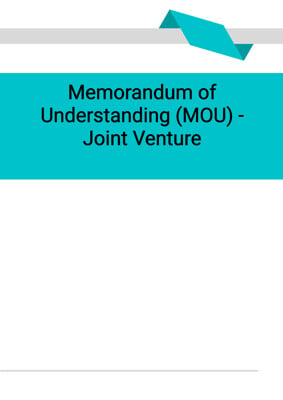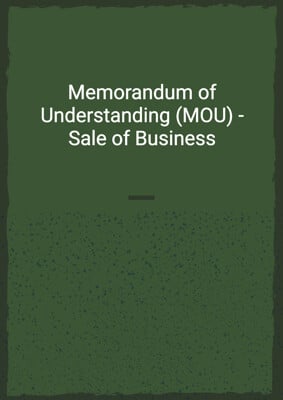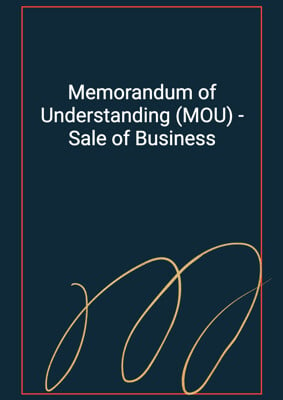
Letter of Intent (LOI) - Sale of Business
Seller
A Letter of Intent (LOI) sent by a seller / vendor to a buyer / purchaser in a sale and purchase situation. This represents the good faith intentions of the parties but also include deposit from the Buyer. This document is drafted from the perspective of the Seller.
How to Tailor the Document for Your Need?
01
Create Document
Fill in the details of the parties. You can click the "Fill with Member’s Information" button to complete it with information saved to your account.
02
Fill Information
Please fill in any additional information by following the step-by-step guide on the left hand side of the preview document and click the "Next" button.
03
Get Document
When you are done, click the "Get Document" button and you can download the document in Word or PDF format.
04
Review Document
Please get all parties to review the document carefully and make any final modifications to ensure that the details are correct before signing the document.
Document Preview
Document Description
The document titled 'Letter of Intent (LOI) - Sale of Business' is a formal letter that outlines the general terms and conditions of a proposed sale of a business. The importance of this document lies in its ability to establish the intentions and expectations of both parties involved in the transaction. It serves as a preliminary agreement that sets the stage for further negotiations and the eventual creation of legally binding transaction documents.
The entire document is divided into several sections, each serving a specific purpose. The first section introduces the purpose of the letter and the parties involved. It emphasizes the intention to reach a detailed agreement based on the principles outlined in the letter. The second section focuses on the proposed transaction itself, detailing the sale of a specific percentage of interest in the target business. It also mentions the assets included in the sale and any conditions imposed by regulators.
The third section addresses the purchase price and payment terms. It specifies the aggregate consideration to be paid by the buyer and the breakdown of the purchase price. It also outlines the payment schedule, including the deposit, the signing of the sales and purchase agreement, and the final payment upon completion of the transaction. The fourth section discusses the transition period, during which both parties will cooperate to ensure the continued operation of the target business. It mentions the role of the current management and the appointment of new board members.
The fifth section highlights the importance of due diligence, which is a necessary step before proceeding with the transaction. It sets a timeframe for completing the due diligence and states that the proposed transaction is subject to satisfactory completion of this process. The sixth section covers termination conditions, including a long stop period and the non-refundability of the deposit in certain circumstances. The seventh section outlines the closing conditions, such as the target's continued operation and the approval of the proposed transaction by the target.
The eighth section mentions the need for third-party approvals, such as consents from partners and regulatory authorities. It emphasizes the importance of obtaining these approvals before completing the transaction. The ninth section addresses confidentiality and announcements, stating that both parties must keep information confidential and obtain approval for any public announcements. The tenth section briefly mentions dispute resolution and the jurisdiction clause.
The eleventh section clarifies that this letter of intent is not legally binding and creates no legal obligations. It emphasizes that the proposed transaction will only proceed when definitive legally binding transaction documents are agreed upon and executed. The twelfth and final section mentions the tax and stamp duty responsibilities of each party.
In summary, this document provides a detailed overview of the proposed sale of a business, covering various aspects such as the transaction itself, purchase price and payment terms, transition period, due diligence, termination conditions, closing conditions, third-party approvals, confidentiality, dispute resolution, and legal obligations.
How to use this document?
1. Review the entire document to understand the purpose and scope of the letter of intent.
2. Pay attention to the proposed transaction section, which outlines the sale of a specific percentage of interest in the target business and any conditions imposed by regulators.
3. Familiarize yourself with the purchase price and payment terms, including the aggregate consideration, payment schedule, and deposit requirements.
4. Understand the transition period and the roles of the current management and the appointment of new board members.
5. Take note of the importance of conducting due diligence before proceeding with the transaction and the timeframe provided for completing this process.
6. Be aware of the termination conditions, including the long stop period and the non-refundability of the deposit in certain circumstances.
7. Ensure that all closing conditions, such as the target's continued operation and the approval of the proposed transaction, are met before proceeding.
8. Identify any third-party consents or approvals that may be required and make necessary arrangements to obtain them.
9. Maintain confidentiality and seek approval for any public announcements related to the transaction.
10. Understand the dispute resolution process and the jurisdiction clause.
11. Remember that this letter of intent is not legally binding and that definitive transaction documents must be agreed upon and executed for the proposed transaction to proceed.
12. Consider the tax and stamp duty responsibilities of each party and make appropriate arrangements.
13. Seek legal advice or consult with professionals experienced in business transactions to ensure compliance with all legal requirements and best practices.
Not the right document?
Don’t worry, we have thousands of documents for you to choose from:
























